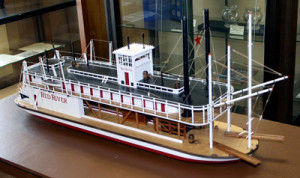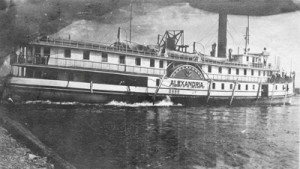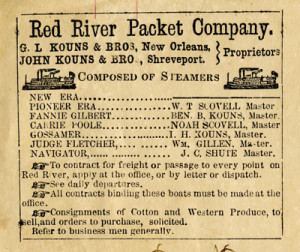
This month, we are going to focus on boat transportation. Early on, canoes and flat bottom “shallow draft” boats prevailed. They traveled up and down the Red River in the 1700’s to early 1800’s. The flat bottom boats were propelled by poles and man power. The Red River highway came to an end at Alexandria. Those who traveled North upriver would encounter two sets of rapids. These rapids served as a stopping off point for the early explorers. Several old maps that I have studied show a portage on the Pineville side going around the rapids. A year or so ago, I went up in an airplane with a pilot friend of mine and searched for remnants of that portage. We could find no signs of it. The upper and lower rapids are gone, covered by the raising of the water level with locks and dams. The lower rapids were located behind present day Rapides Regional Medical Center. The upper rapids were located near Bulow lake and the railroad bridge across Red River.

Just before the Civil War, the steamboat reached its peak. They were the major distributors of goods up and down the Red and Mississippi. Everything from bacon to lace and lumber made its way to up and down the rivers of Louisiana. It was the fastest and cheapest transportation for that time. Another boat named for this area was the Red River steamer. It was a rear paddle wheeler that was active in the late 1800’s up until about 1910. A scale model of the Red River steamer is on display at the Louisiana History Museum.

One major company that operated ships on the Red River was the Red River Packet Company. Its New Orleans office was run by G.L. Kouns & Bros., and the Shreveport office was run by John Kouns & Bros. This Company was composed of the steamers New Era, Pioneer Era, Fannie Gilbert, Carrie Poole, Gossamer, Judge Fletcher and the Navigator. All of these ships traveled from New Orleans to Shreveport on a regular schedule. I have included the advertisement of the Red River Packet Company, the Side wheeler Alexandria and the Red River packet boat.
Transportation on the Red River was useful up to the 1920’s. Steadily thereafter, steam trains became the fastest and safest mode of commercial transportation.
For more information and pictures, visit www.louisianahistorymuseum.com or stop by the Louisiana History Museum at 503 Washington Street in downtown Alexandria. I can be contacted by email at [email protected].









